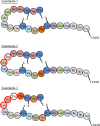The role of endothelin-1 in pulmonary arterial hypertension
- PMID: 25405182
- PMCID: PMC4220438
- DOI: 10.5339/gcsp.2014.29
The role of endothelin-1 in pulmonary arterial hypertension
Abstract
Pulmonary arterial hypertension (PAH) is a rare but debilitating disease, which if left untreated rapidly progresses to right ventricular failure and eventually death. In the quest to understand the pathogenesis of this disease differences in the profile, expression and action of vasoactive substances released by the endothelium have been identified in patients with PAH. Of these, endothelin-1 (ET-1) is of particular interest since it is known to be an extremely powerful vasoconstrictor and also involved in vascular remodelling. Identification of ET-1 as a target for pharmacological intervention has lead to the discovery of a number of compounds that can block the receptors via which ET-1 mediates its effects. This review sets out the evidence in support of a role for ET-1 in the onset and progression of the disease and reviews the data from the various clinical trials of ET-1 receptor antagonists for the treatment of PAH.
Figures








References
-
- Simonneau G, Robbins IM, Beghetti M, Channick RN, Delcroix M, Denton CP, Elliott CG, Gaine SP, Gladwin MT, Jing ZC, Krowka MJ, Langleben D, Nakanishi N, Souza R. Updated clinical classification of pulmonary hypertension. Journal of the American College of Cardiology. 2009;54(1 Suppl):S43–S54. - PubMed
-
- Peacock AJ, Murphy NF, McMurray JJ, Caballero L, Stewart S. An epidemiological study of pulmonary arterial hypertension. The European respiratory journal. 2007;30(1):104–109. - PubMed
-
- Sitbon O, Lascoux-Combe C, Delfraissy JF, Yeni PG, Raffi F, De Zuttere D, Gressin V, Clerson P, Sereni D, Simonneau G. Prevalence of HIV-related pulmonary arterial hypertension in the current antiretroviral therapy era. American journal of respiratory and critical care medicine. 2008;177(1):108–113. - PubMed
-
- Channick RN, Simonneau G, Sitbon O, Robbins IM, Frost A, Tapson VF, Badesch DB, Roux S, Rainisio M, Bodin F, Rubin LJ. Effects of the dual endothelin-receptor antagonist bosentan in patients with pulmonary hypertension: a randomised placebo-controlled study. Lancet. 2001;358(9288):1119–1123. - PubMed
-
- Hachulla E, Gressin V, Guillevin L, Carpentier P, Diot E, Sibilia J, Kahan A, Cabane J, Francès C, Launay D, Mouthon L, Allanore Y, Tiev KP, Clerson P, de Groote P, Humbert M. Early detection of pulmonary arterial hypertension in systemic sclerosis: a French nationwide prospective multicenter study. Arthritis and rheumatism. 2005;52(12):3792–3800. - PubMed
Publication types
LinkOut - more resources
Full Text Sources
Other Literature Sources
